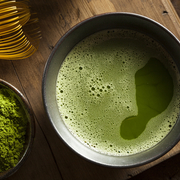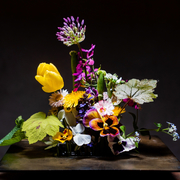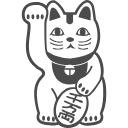Himiko at the Rise of Calligraphy
It is believed that Japan did not have its own letters at first and those were generated from Chinese characters.
It is not clear about the exact time when calligraphy started, but some assumptions are presented from analyzing of the remaining articles.
The article which tells Chinese characters were introduced to Japan, is “Kan-no-Wa-no-Na-no-Kokuo (King of Na)” gold seal.
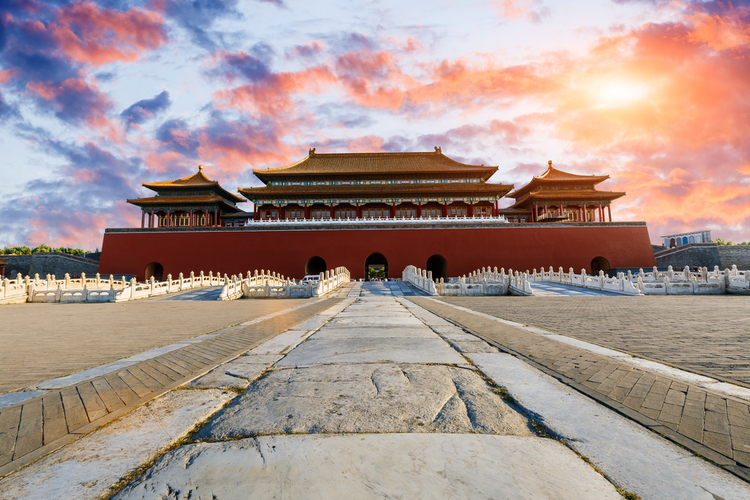
This gold seal was excavated in the Edo period(1603-1867).
It is regarded that the Emperor Guangwu, the first emperor of the Gokan period in China, gave the gold seal to the messenger from Nakoku (Na-state) of Japan, which was assumed to be located near the current Fukuoka, in the year 57 AD, which is 2000 years ago.
From the style of letters on the gold seal, Japanese first letters were in Tensho-tai (seal script-style).
Besides “Kan-no-Wa-no-Na-no-Kokuo (King of Na)” gold seal, a bronze mirror is also well-known as an article of that time.
Around 150 years after 57 AD, when “Kan-no-Wa-no-Na-no-Kokuo (King of Na)” gold seal was said to be made, in the year of 220 AD, in “Gisho” of Three Kingdoms, which is the Chinese historical book, Queen Himiko was mentioned as the leader governing states of Wa mentioned above.
There was description that Himiko “did Choko※1 to Gi, which was the dynasty of China, several times and received many mirrors from Gi”.
※1 Choko: Foreign messengers visits the court to send gifts.
“Suda Hachiman Jinbutsu Gazo-kyo (Suda Hachiman Shrine Mirror)”, which is the found article, was said to be copied of Chinese-made mirror.
This led to the idea that this mirror was sent to Himiko from Gi.
Chinese characters written on the bronze mirror shows that letters spread widely in Japan from China.
Then, from the Yayoi period(around 10century BC to 3 century BC) to Nara period, various stories were born from letters.

From the Nara to the Heian period, the Establishment of Calligraphy began from Shakyo
In the Nara period (started in 710 AD), Buddhism spread and Empress Komyo, who was the wife of Emperor Shomu, transcribed sutras such as;
- Issai-kyo
- Kegon-kyo
The transcribed sutras by her came to get known.
The one of Kegon-kyo was called “Konshi Ginji Kegonkyo”.
Those Shakyo (transcribed sutras) were said to be the origin of calligraphy.
I n 741 AD, In the Nara period, Sutras become Art
One of the transcribed sutras, which was the beginning of establishment of calligraphy, was called “Kako Genzai Inga-kyo”, which was the sutra describing the previous life and the biography of Buddha, who is the founder of Buddhism.
That has pictures in the upper half of the paper and transcribed sutra in the lower.
This “Kako Genzai Inga-kyo”, which existed from the Nara to the Kamakura period, is also well known as an artwork of picture.
8 09-833 AD In the Heian period towards Dynasty Culture
In the Heian period, as Nosho※2,
- Saicho
- Kukai
- Tachibana no Hayanari
are known as “Sanpitsu (three famous calligraphers)”.
※2 Nosho: A person who has good handwriting.
Among them, Kukai is one of the most famous monks in Japan known as “Kobo Daishi”.
The famous saying “Even Kobo Daishi’s handwriting contains mistakes.(Even Homer sometimes nods.)” came from Kukai.
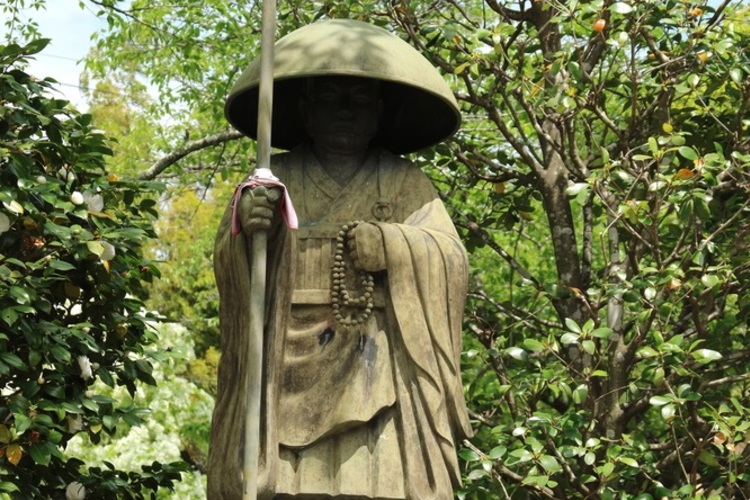
Tachibana no Hayanari also studied in China and came back to Japan with Kukai.
His class as the aristocracy was low, but his talent of calligraphy made him famous.
Saicho is the famous monk, who built Enryaku-ji Temple Hieizan and expanded Tendai-shu in the Heian period.
Saicho, learnt the style of calligraphy by the politician of Toshin in China, “Ou Gishi”, who was also a calligrapher, and succeeded it.
After he returned to Japan, Saicho took in the style of the politician of Todai in China “Gan Shinkei”, who was also a calligrapher, to spread it.
Thus, Japanese calligraphy was developed with influences of famous Chinese calligraphers and was inherited to today.
I n 928 AD, in the middle of Heian period, Calligraphy as Beautiful Japanese Culture
In the middle of Heian period, Kentoshi (Japanese envoy to China in the Tang Dynasty) was abolished.
- Ono no Michikaze
- Fujiwara no Sukemasa
- Fujiwara no Yukinari
There three masters of calligraphy appeared.
The three were called as “Sanseki”.
Ono no Michikaze took in the style of Ou Gishi, who was the Chinese politician and the calligrapher, and wrote beautifully in the style of Gyosho-sho※3.
※3 Gyosyo-sho: Gyosyo (semi-cursive) and Sosho (cursive)
Fujiwara no Sukemasa, who was influenced by Michikaze, left the more free and beautiful writing.
His calligraphy is popular even today.
Fujiwara no Yukinari is known as the person who wrote in the smooth and elegant style, which was improved from the combination of Ou Gishi’s style and Michikaze’s.
I n 995 AD, in the Heian period, under the Fujiwara regime, Sei Shonagon and Murasaki Shikibu appeared
Fujiwara no Saneyori, whose grandfather was Fujiwara no Sukemasa, established the regency.
His nephew, Fujiwara no Michitaka and Fujiwara no Michinaga, succeeded its history.
Sei Shonagon was the court lady for the eldest daughter of Michitaka, Fujiwara no Teishi, the wife of Emperor Ichijyo.
Murasaki Shikibu was the court lady for the daughter of Michinaga, Fujiwara no Shoko, the wife of Emperor Go-Ichijo.
Thus, it is the well-known story that there were many people with a literary and calligraphy talent.
Surprising Episodes of Kukai and Kaiso, the Master and Mania of Calligraphy in Japan and China.
Japanese calligraphy was hugely influenced by Chinese calligraphers like Ou Gishi, Gan Shinkei and was inherited.
Even today, the calligraphy of Kukai is said to be the model of Japanese calligraphy.
Kukai, actually, studied Chinese such as Bonji and Shittan Moji in China in the Tang Dynasty.
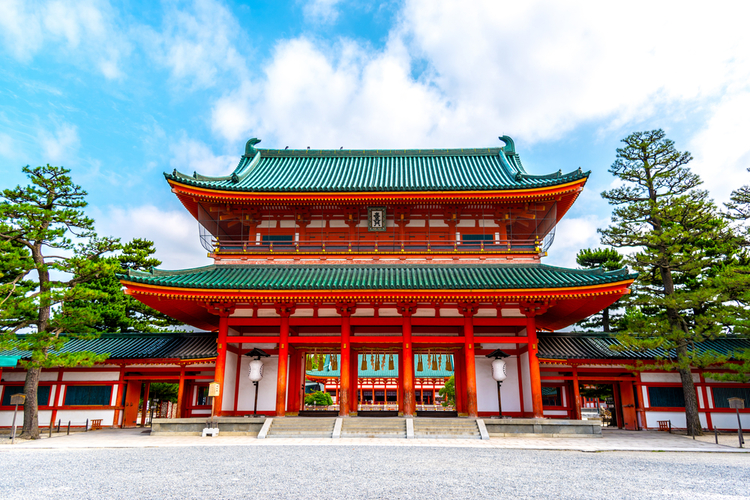
Kukai had another name of “Gohitsu Osyo (monk with five brushes)”.
He was said to write five lines at once on walls holding one brush each with each hand, one each with each foot, and one in mouth.
Also, there was the story that, when he was requested to write the name of “Outen-mon Gate” of Heian Shrine, he threw the brush to finish the left part when he found forgetting the part of one letter after his writing was framed and help up.
These episodes made him known as “eccentric” master of calligraphy free from the style.
In China, there was the famous monk called “Kaiso Osho” resembling Kukai.
His style was based on Ou Gishi, but its free and elegant cursive style was described as “Kyoso”.
He was normally earnest and gentle, but once he drank, he could not stop himself writing letters, which ended in writing cursive scripts everywhere in his eyes such as a desk, a wall, Kimono of people around him.
This made him called as “Sosho-mania monk”.
Mysterious and Interesting Story about the Great master of Calligraphy
There was a mysterious story about one of the Sanseki, Fujiwara no Sukemasa.
In 997, the boat of the group of Sukemasa, who were on the way from Dazaifu to Kyoto, stuck at the coast of Omishima in Iyo-state (the current Ehime) without any winds and waves to disturb.
At that night, Omishima Shrine appeared in Sukemasa’s dream as an old man asking “can you write the tablet of the shrine?”.
Sukemasa accepted it and wrote the tablet.
After that, his group could make the trip back to Kyoto safely.
This story made him called as the best calligrapher in Japan.
The reason why this kind of mysterious and interesting story were told may lie in his figure who has strong influences.
Calligraphy is essentiall to Japanese history and culture, and has more interesting stories with various backgrounds.
We strongly recommend you this beautiful Japanese culture!


